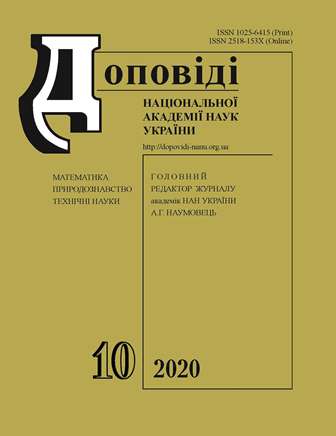Determining the stress concentration change with time in a viscoelastic orthotropic solid
DOI:
https://doi.org/10.15407/dopovidi2020.10.028Keywords:
finite element method, incremental viscoelastic formulation, stress concentration, viscoelastic orthotropic plateAbstract
The procedure for solving the plane problem of the linear theory of viscoelasticity by the finite element method is described. Based on the virtual work principle and the assumption of the constancy of the strain rate at small intervals of time, the matrix form of the equilibrium equations of the finite-element approximation of a body is written. The solution procedure is described for the constitutive relations in the Boltzmann—Volterra integral form. This integral is transformed into an incremental form on a time mesh, at each interval of which the problem is solved by the finite element method with unknown increments of displacements. The numerical procedure is constructed by ununiformly dividing the time interval, at which the study is conducted. In this case, the stiffness matrix requires recalculation at each time step. The relaxation functions of the moduli of a viscoelastic orthotropic material are described in the form of the Proni—Dirichlet series. The solution to the problem of determining the change over time of the stress concentration in a body with a round hole in a viscoelastic orthotropic plate is presented. To construct a numerical solution, the three moduli of orthotropic material were written using one exponent with the same relaxation time. For these initial data, an analytic expression for the viscoelastic components of the stiffness matrix of an orthotropic plate under plain stress conditions is constructed. Numerical examples are presented for several ratios of the hole radius to the size of the plate. These results are compared with the solution obtained for an infinite plate by inverse transformation by a numerical method of the well-known analytic elastic solution.
Downloads
References
Christensen, R. M. (1982). Theory of viscoelasticity. New York: Academic Press Inc.
Kaminsky, A. A., Selivanov, M. F. & Chornoivan, Y. O. (2016). On the long-term deformation process in viscoelastic composites around an elliptical hole. Mech. Time-Depend. Mat., 20, No. 2, pp. 233-243, https://doi.org/10.1007/s11043-016-9293-0
Kaminsky, A. A., Selivanov, M. F. & Chornoivan, Yu. A. (2013). Subcritical Growth of a Mode III Crack in a Viscoelastic Composite Body. Int. Appl. Mech., 49, No. 3, pp. 293-302, https://doi.org/10.1007/s10778-013-0567-9
Kaminsky, A. A. & Selivanov, M. F. (2003). A method for solving boundary-value problems of linear viscoelasticity for anisotropic composites. Int. Appl. Mech., 39, No. 11, pp. 1294-1304, https://doi.org/10.1023/B:INAM.0000015599.90700.86
Zocher, M. A., Groves, S. E. & Allen, D. H. (1997). A three-dimensional finite element formulation for thermoviscoelastic orthotropic media. Int. J. Numer. Meth. Engng., 40, No. 12, pp. 2267-2288. https://doi.org/10.1002/(SICI)1097-0207(19970630)40:12<2267::AID-NME156>3.0.CO;2-P
Chazal, C. & Pitti, R.M. (2011). Incremental constitutive formulation for time dependent materials: creep integral approach. Mech. Time-Depend. Mat., 15, pp. 239-253, https://doi.org/10.1007/s11043-011-9135-z
Downloads
Published
How to Cite
Issue
Section
License
Copyright (c) 2023 Reports of the National Academy of Sciences of Ukraine

This work is licensed under a Creative Commons Attribution-NonCommercial 4.0 International License.



